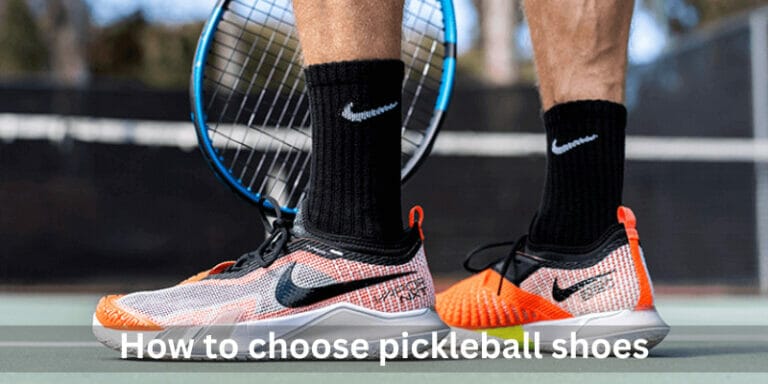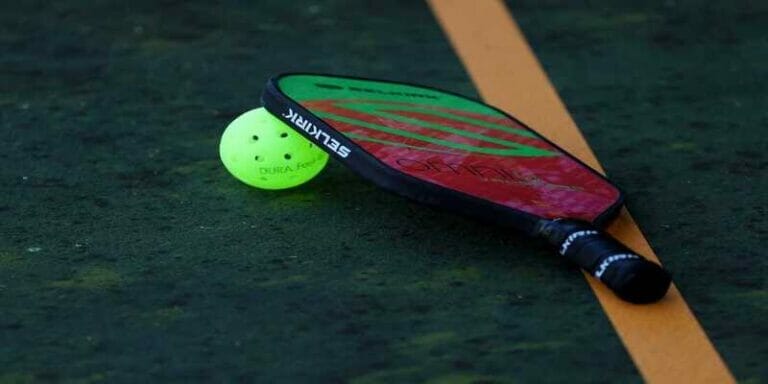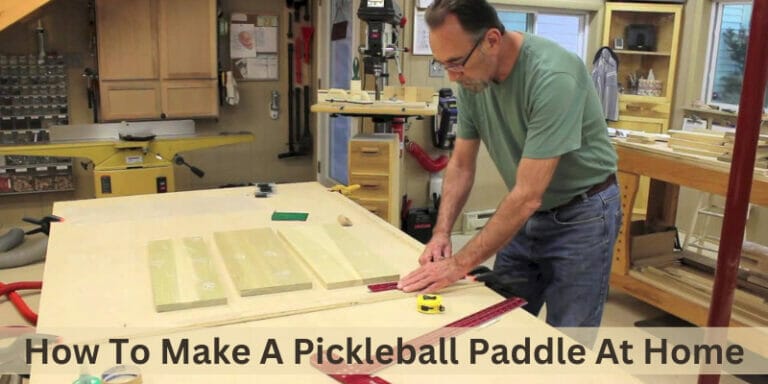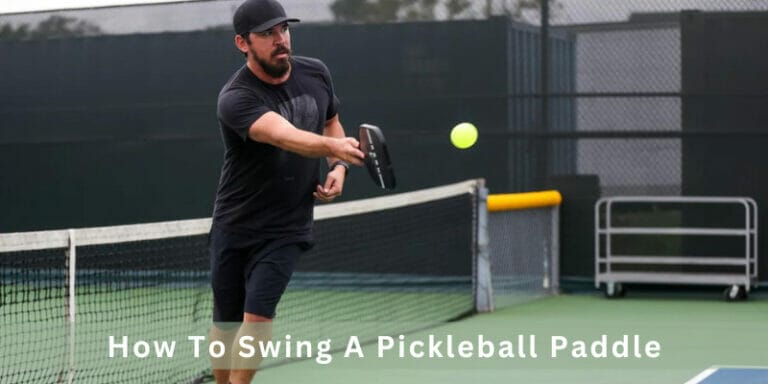How To Paint A Pickleball Court | Complete Guide

Serve up some serious style on your pickleball court with these painting techniques.
First, clean the surface thoroughly and let it dry. Then, apply masking tape to mark the playing area and create sharp lines intersect. Next, use a paint roller or spray machine to apply two coats of acrylic paint, allowing them to dry completely between coats. Finally, remove the masking tape and let the court cure for at least 72 hours before play pickleball.
It was a challenge, but it was worth it. First, I had to clean the court thoroughly to ensure the paint would adhere properly.
Applying the masking tape to create sharp lines was time-consuming, but it helped make the court look professional. I applied two acrylic resurfacer using a roller and let them dry completely. The best result was fantastic, and my friends and I enjoyed playing on the newly painted court.
This article covers everything you need to know about how to DIY pickleball court or pickleball players.
Let’s get started!
Materials Needed for Painting a Pickleball court
when you want to paint, we always required materials,s and here are the main essentials to paint yours.
- Paint
- Paint rollers
- Paint with a brush
- Paint trays
- Painters tape
- Measuring tape
- Chalk line tool
- Pressure washer or blower
- Surface cleaner or degreaser
- Repair materials (e.g., crack filler, patching compound)
- Court stencils (optional)
- Protective gear (e.g., gloves, goggles, masks)
Step By Step Guide How to paint a pickleball court
So there is the following guide that helps you to paint your pickleball court surface and I mentioned the step-by-step guide to painting your court is below:
Step 1: Clean the Court Surface
The first step is to clean it thoroughly. Use a power wash on the surface or a hose to remove dirt, debris, and other particles.
Make sure the court into pickleball court is completely dry before proceeding to the next step.
Step 2: Measure and Mark the Court
Use measuring tape and a chalk line to mark the boundaries of the court area. A standard court is 20 feet wide and 44 feet long. Mark the sidelines first, then the baselines, and finally, the centerline.
Step 3: Apply Primer
Use a roller or a sprayer to apply a coat of primer on it. The primer will help the painted line adhere better and last longer. Allow the primer to dry completely before proceeding to the next step.
Step 4: Apply Paint
Use a roller or a sprayer to apply the pickleball paint on it. The most commonly used color is blue, but you can choose any color you like.
Apply the paint thin, and let each coat dry completely before applying the next one.
Step 5: Apply the Second Coat of Paint
After the first paint has dried completely, apply a second coat of paint onto it. This will help ensure that the surface is fully covered and the color is even.
Step 6: Apply Line Paint
Use a stencil and a roller to mark it. Paint the lines on the court should be 2 inches wide and white. Make sure the adding lines are straight and even.
Step 7: Allow the Court to Dry
Allow the court to dry completely before playing on it. The drying time will vary depending on the weather conditions and the type of paint you used, but it typically takes at least 24 hours.
Benefits of the painting pickleball court
Painting is important in ensuring that the court is safe, durable, and functional for players of all levels. Here are some of the key benefits of painting.
Improved Visibility:
One of the main reasons to paint is to improve visibility. A painted court is easier to see than an unpainted one, which helps players more accurately judge the ball’s location and avoid collisions.
Clear Court Markings:
It allows for clear and precise court markings, essential for playing the game correctly. This includes lines for the court boundaries, the kitchen, the service area, and the non-volley zone.
Clear markings also help players understand the game’s rules and avoid foot faults.
Longer Lasting Court:
High-quality paint ensures the court will last longer and be more durable. A well-maintained painted court can last many years, even with regular use.
Enhanced Safety:
A painted court provides a safer playing surface, as it is less likely to become slippery or uneven. The paint also helps to protect the court surface from weather damage and wear and tear.
Professional Appearance:
It looks more professional and attractive, which can attract more players and increase usage. This is particularly important for the community and public courts that are open to the public.
Customizable:
And It allows for customization of the entire court appearance. This can include choosing colors the court surface and lines inside that match the surrounding environment or adding logos or other designs.
Techniques For Painting A Pickleball court
So, what changes can you make to an existing court, or how can you paint a new court from scratch to start playing pickleball?
Here are some unique techniques to consider when you paint it.
Techniques 1:Use a stencil
Consider using a stencil to ensure the court lines are straight and evenly spaced. You can purchase pre-made stencils or create your own using cardboard or a plastic sheet.
Secure the stencil with weights or tape and apply the paint with a roller or sprayer.
Techniques 2:Apply multiple coats
Applying multiple paints can help ensure the court lines are visible and durable. Apply one primer and two or three coats of paint, allowing each to dry completely before applying the next.
Techniques 3:Mix non-slip additives
It can be slippery when wet, so consider mixing a nonslip additive into the paint. These additives can be purchased at a hardware store and are typically made of fine particles like cement and sand or soft rubber granules.
Mix the additive into the paint before applying it to the court.
Techniques 4:Use a sprayer
Using a paint sprayer can help ensure an even and professional-looking finish. Be sure to choose a sprayer designed for outdoor pickleball court use and handle the paint you use.
Techniques 5:Apply tape to the net posts
To avoid getting painted on the net posts, apply masking tape to the bottom of each post before painting the court. This will help ensure a clean and professional-looking finish.
Techniques 6:Let the paint dry completely
Letting the paint dry completely before playing on the court is important. This can take several days, depending on the weather and humidity. Read the manufacturer’s instructions on the paint can for recommended drying times.
Following these techniques ensures that surfacing a pickleball court is painted professionally and provides a durable surface for years.
Why Is Painting a Pickleball Court Important?
Painting a pickleball court is more than just an aesthetic choice – it’s also necessary for safety and performance reasons.
A well-painted court provides better visibility for players, making it easier to track the ball and judge the boundaries of the court.
A properly painted court can enhance the playing experience by improving ball bounce and reducing glare.
Effects That Different Paints Can Have
The type of paint used on a court can affect its appearance, durability, and safety.
Here are some effects that different paints can have on a court:
Color:
The color of the paint can affect the visibility of the lines and the overall appearance of the court. Bright colors such as blue, green, and red are commonly used for pickleball courts.
Durability:
The durability of the paint can affect how long the court will maintain its appearance and remain playable. Some paints may chip or fade over time, requiring more frequent repainting.
Texture:
The paint’s texture can affect the court’s traction and slip resistance. Textured paints can help improve grip and prevent slips and falls, especially when the court is wet.
Reflectivity:
The paint’s reflectivity can affect how hot the court gets in direct sunlight. Lighter colors reflect more sunlight and may be cooler, while darker colors absorb more heat and become hotter.
Environmental impact:
Some paints may contain harmful chemicals or VOCs (volatile organic compounds), which can be released into the air during application and affect the environment and health of those applying the paint.
Choosing low-VOC or environmentally friendly paints can help minimize these effects.
By considering these effects, you can choose a paint appropriate for your court that meets your needs in terms of appearance, durability, safety, and environmental impact.
Potential Drawbacks Of Painting Your Pickleball Paddle
when we have many benefits, there are also potential drawbacks. Here are some potential drawbacks of painting your:
Cost:
It can be expensive, especially if you hire a professional to do it for you. The cost of paint, equipment, and labor can add up quickly, and you may need to repaint the court every few years to maintain its appearance and safety.
Maintenance:
Painted surfaces require regular maintenance to remain in good condition. You may need to clean the court more frequently to remove dirt, debris, and stains.
Additionally, you may need to repaint the court more frequently in high-traffic areas or areas exposed to direct sunlight.
Slipperiness:
Some types of paint can make the court slippery, especially when wet. This can increase the risk of falls and injuries, especially for older or less experienced players.
Permanence:
Once you finish painting, removing the paint can be difficult or expensive if you change your mind or want to sell your property. This can limit your flexibility and options in the future.
Considering these potential drawbacks, you can decide whether painting your pickleball court is the right choice.
Conclusion
it is essential in creating a safe and enjoyable playing surface. Following the steps outlined in this article, you can create a high-quality court that provides years of playing enjoyment.
Remember to choose the right paint, prepare the surface properly, and take your time to ensure to paint pickleball lines are accurately and evenly applied.
With a little effort and attention to detail, you can have your private pickleball court ready for endless hours of fun and competition.
FAQs
What Kind Of Paint Do You Use On A Pickleball Court?
You should use a specifically designed acrylic paint for the outdoor court. These paints are durable, weather-resistant, and provide good traction for players.
What Color Is Best For A Pickleball Court?
The standard color is light blue or green, but you can choose other colors that suit your preferences. Just make sure that the colors you choose contrast well with the lines of the court for visibility.
How Many Gallons Of Paint Do I Need To Paint A Pickleball Court?
This will depend on the size of your court, but typically, you will need around 6-8 gallons of paint court is covered by a standard usa pickleball association. It’s always best to buy extra paint if you need to do touch-ups.






